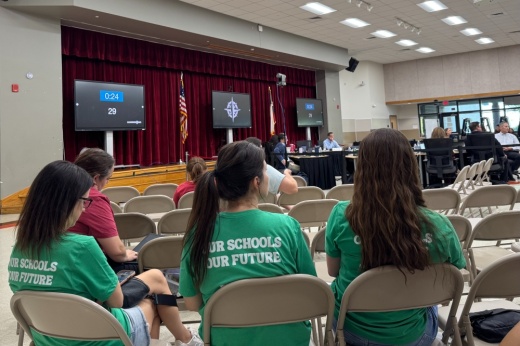PASA President Stacey Tepera and demographer Caroline Couch presented the report to the board of trustees during the Oct. 23 board meeting.
How it works
One of the first steps PASA takes in the demographic process is entering the addresses of all LISD enrolled students onto a map, or geocoding.
On the current demographic map, students enrolled this school year are shown in red, and students enrolled in 2022-23 are shown in gray. Layering the map this way more clearly points to where new housing construction is, Tepera said.
"The only time you see current students in red is when they are not hidden by a previous student in gray," Tepera said. "The current students that you can see on this map are the only places where students are living now, and there were no students living there three years ago."

According to Tepera, LISD is past its high-growth phase and is approaching a stabilization phase.
Between 2019 and 2024, the population of people living within LISD boundaries has increased by about 12%, but the proportion of school aged children has gotten smaller, from 21% to 18%.
Because the district is geographically large, there are parts that are continuing to grow while others have stabilized or declined, Tepera said.
Still, LISD has not recovered from its drop in enrollment after the COVID-19 pandemic, which Tepera said is not just a "blip" but the new normal.
"This makes it really clear to me that this is a new trend, that this is a new reality," Tepera said. "There are a lot of moving parts that are driving this."
Another detail
According to Couch, there are seven subdivisions being developed over the next 10 years that will add over 2,100 units and eight planned subdivisions that could add over 3,000 units. All 15 subdivisions are located in the north or north-central part of the district.
Through 2030, steady new housing activity will be concentrated primarily east of Ronald Reagan Boulevard. By 2035, however, that growth will move to the west and northwest area of the district, she said.
There are also 11 multi-family developments currently leasing units and five planned multi-family developments that could add over 1,900 units.
These developments are located throughout the district, but is expected to only have a 22% impact on student enrollment as most of these properties are geared toward young professionals with smaller units and higher rents, Couch said.
"Even with all of the thousand of new homes that have been built over the past 12 years, the number of students moving into those homes is not as high as it used to be," Tepera said.
The most easily identifiable reason for LISD's declining student ratios is due to alternative educational opportunities, Tepera said.
In 2014, there were 25 charter schools in the area that enrolled students who lived within LISD boundaries. That number has nearly tripled since then to 68 charter schools.
There is also a growing homeschool population, but these numbers are harder to track, she said.
Something to note
Housing regeneration is often a topic of conversation in districts including LISD, Tepera said.
Some community members have suggested that their neighborhoods are regenerating due to homes being sold in their neighborhood and seeing babies or new families moving in.
However, regeneration drives stabilization, not growth, Tepera said.
A house in a new neighborhood will either be sold to someone who does or does not have an LISD student. Regardless, there will be growth in enrollment in these neighborhoods, she said.
Alternatively, a house on the market in an existing neighborhood either contains an LISD student or does not. When it sells to a new owner, they either have an LISD student or not. This nets zero change, or stabilization, as there is always a population of students moving out that balances out any growth.
Going forward
Making district decisions based off long-term projections that could fluctuate has been questioned, Tepera said. Similarly-sized districts are facing similar challenges but understand the fluidity of projections and that they are based on assumptions.
"Projections are projections; they are not predictions," Tepera said. "There could be unpredictable and unimaginable events that could significantly impact enrollment, and these districts are recognizing that we still have to move forward and we still have to make decisions about long-range planning based on the best information that we have available."





